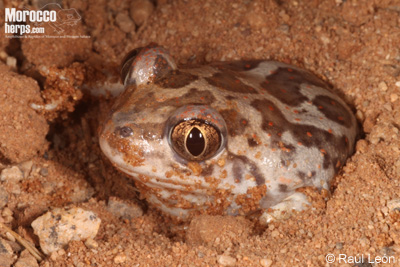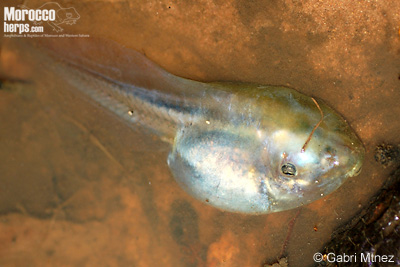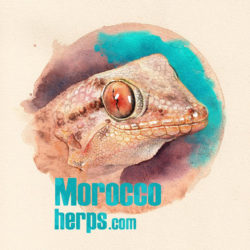Moroccan Spadefoot Toad
Pelobates varaldii Pasteur & Bons, 1959
By Gabriel Martínez del Mármol Marín
Updated: 23/09/2012
Taxonomy: Anura | Pelobatidae | Pelobates | Pelobates varaldii


 Pelobates varaldii
Pelobates varaldii
Distribution map of
Pelobates varaldii
in Morocco.
Gallery: 18 photos. [ENTER]
Phylogenetic frame
Until 1959, the Moroccan spadefoot toads were considered to belong to the species Pelobates cultripes (Cuvier, 1829). However in that year were separated as a distinct species based on morphological criteria (Pasteur & Bons in Bons & Geniez, 1996), which was subsequently confirmed with electrophoretic and immunological analysis (Busack et al., 1985).
Description

Moroccan spadefoot toad is an anuran with smooth skin and without paratoid glands typical of most species of toads. Males are about 6.5 cm total length and females more, with an average of 7 cm (Bons & Geniez, 1996; de Pous & Beukema, 2011). The head is broad with a slightly pointed snout. The eyes are large and prominent, coppery-yellow color with small black spots. The pupil is vertical and black. They often have red spots above the eyes and in the dorsal and lateral areas. The background color is gray-brown with marks darker than the background color.
It has black metatarsal tubercles to help it in its burrowing habits.
It´s easily differentiated from other amphibians in Morocco to be the one with vertical pupil and smooth skin. Alytes maurus, the other amphibian with vertical pupil present in the study area has rough skin (Schleich et al., 1996).
Ecology and habits
It is a predominantly nocturnal species with special physiological adaptations to withstand long periods of inactivity buried (Schleich, 1996). This anuran is a excellent excavator. Thanks to its dark tubercles which has in the legs is able to quickly buried in the soil of sandy areas and loose soil where they live.




With the arrival of the temperate rain after the hot and dry summer, they leave their burrows and flocking to time locations of water to breed. Once in the water the males start calling females with a sound audible up to 2 Km away. Male fights may occur. When a female goes to the place of spawning, the male grab the female by the waist (inguinal amplexus) and after a long period submerged, which can last several days, the female releases eggs into the water in areas not too deep and the male fertilizes them. The clutch consist of up to 1000 eggs in a string of 1-1,5 m long gray with 0.11 to 0.2 cm of diameter. The tadpoles hatch within a maximum of one week since its start, a very short time, which is part of the adaptive strategy of this anuran to temporary aquatic points. Tadpoles feed on plankton and detritus, reaching up to 13 cm in length before metamorphosis, which occurs in may and june. Pelobates varaldii tadpoles differ from those of other species to reach larger sizes and have 5 rows of denticles on the lower lip. At the completion of metamorphosis the young toads are between 2.1 to 3.4 cm (Schleich, 1996; de Pous & Beukema, 2011).



In its diet includes lots of invertebrates captured in the vicinity of its burrow, not travel long distances to hunt (de Pous & Beukema, 2011).

As predators has been cited the barn owl (Tyto alba, in Bons & Geniez Thevenot, 1996). In many points where this anuran breeding is often found the viperine snake (Natrix maura). This snake must prey on individuals of all ages, although it has only been confirmed predation on the tadpoles (J. Gállego pers. comm.). Pelobates varaldii prevents most predators buried, leaving no entrance in its hole and being very difficult to locate. If it´s caught, it can emit a sharp sound or release urine to try to deter potential predators (Schleich, 1996).
Distribution, habitat and abundance
This toad has been found in coastal areas of Morocco from Tanger (30STE34) in the north to Oualidia in south, penetrating inland to Sidi Slimane, reaching a maximum altitude of 350 m (Bons & Geniez, 1996; Lapeña et al., 2011). It lives in sandy areas undisturbed and preventing the cultivated areas (de Pous & Beukema, 2011). It has only been located in areas of sandy substrate where this amphibian can be buried easily.

According to IUCN criteria, the moroccan spadefoot toad is in a conservation state of “endangered” (EN: Salvador et al., 2006).

Threats of this anuran are diverse. Intensified grazing affects their spawning areas transforming their habitat and polluting its breeding places with abundant livestock waste. The extension of cultives also affects populations of moroccan spadefoot toad. Their points of breeding are limited to points of temporary water because in the permanent water points have been introduced a species of predatory fish like Gambusia holbrooki (Schleich et al., 1996, Salvador et al., 2006; de Pous & Beukema, 2011). It´s usually found fallen in cisterns and other human buildings that behave as traps, and also it usually must dead on roads, like the other amphibians species in Morocco.
References
- Bons, J. & Geniez, P. 1996. Anfibios y Reptiles de Marruecos. Asociación Herpetológica Española, Barcelona. 319 pp.
- Busack, S.D., Maxson, L.R. & Wilson, M.A. 1985. Pelobates varaldii (Anura: Pelobatidae): a morphologically conservative species. Copeia 1985: 107-112.
- Crochet, P.A. & P. Geniez. 2003. First live record of Pelobates varaldii Pasteur & Bons, 1959 in the Oualidia area, Morocco. Herpetozoa 16(1/2): 93 – 94
- de Pous, P. & Beukema, W. Moroccan Spadefoot Toad (Pelobates varaldii). In Edge Existence. www.edgeofexistence.org. Downloaded on 17 February 2011
- de Pous, P. & Dingemans, D. 2009. The moroccan spadefoot toad. In Edge Existence. www.edgeofexistence.org. Downloaded on 17 February 2011
- Herrero, P. & Talavera, R.R. 1988. Cytotaxonomic studies on Iberian and Moroccan Pelobates (Anura: Pelobatidae).
Acta Zoologica Cracoviensia 31(17): 505-508. - Lapeña, M.; Barbadillo, L.J. & Martínez-Solano, I. 2011. Geographic Distribution. Pelobates varaldii. Herpetol. Rev., 42(1): 108.
- Mateo, J.A., Plegezuelos, J.M., Fahd, S., Geniez, P. & Martínez-Medina, F.J. 2003. Los Anfibios, los Reptiles y el Estrecho de Gibralter. Un ensayo sobre la Herpetofauna de Ceuta y su entorno. Instituto de Estudios Ceuties, Ceuta. 388 pp.
- Salvador, A.; Donaire-Barroso, D.; Slimani, T; El Mouden, E.H.; Geniez, P. 2006. Pelobates varaldii. In: IUCN 2010. IUCN Red List of Threatened Species. Version 2010.4. . Downloaded on 17 February 2011
- Schleich, H. H., Kästle, W. & Kabisch, K. 1996. Amphibians and Reptiles of North Africa. Koeltz Sci. Books, Koenigstein. 630 pp.
To cite this page:
Martínez del Mármol Marín G. 2012. Pelobates varaldii Pasteur & Bons, 1959. In: Martínez, G., León, R., Jiménez-Robles, O., González De la Vega, J. P., Gabari, V., Rebollo, B., Sánchez-Tójar, A., Fernández-Cardenete, J. R., Gállego, J. (Eds.). Moroccoherps. Amphibians and Reptiles of Morocco. Available from www.moroccoherps.com/en/ficha/Pelobates_varaldii/.
To cite www.morocoherps.com en as a whole:
Martínez, G., León, R., Jiménez-Robles, O., González De la Vega, J.P., Gabari, V., Rebollo, B., Sánchez-Tójar, A., Fernández-Cardenete, J.R., Gállego, J. (Eds.). Moroccoherps. Amphibians and Reptiles of Morocco. Available from www.moroccoherps.com.

